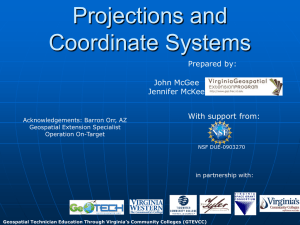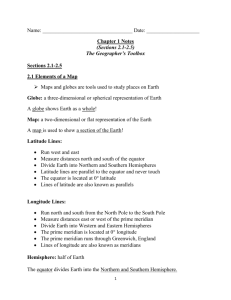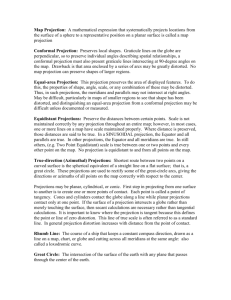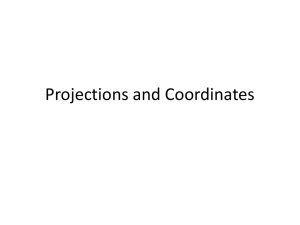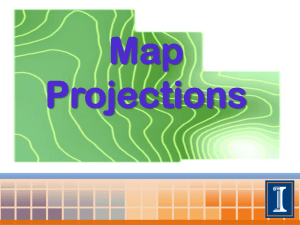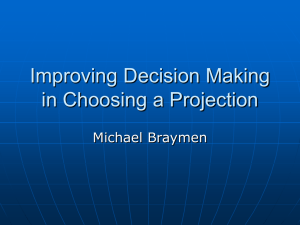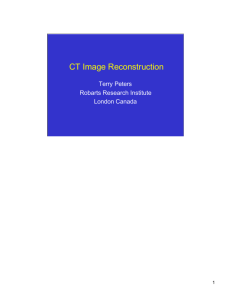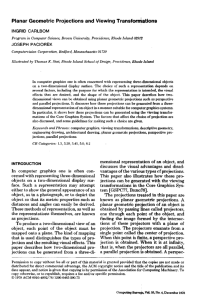CS465 Computer Graphics
advertisement
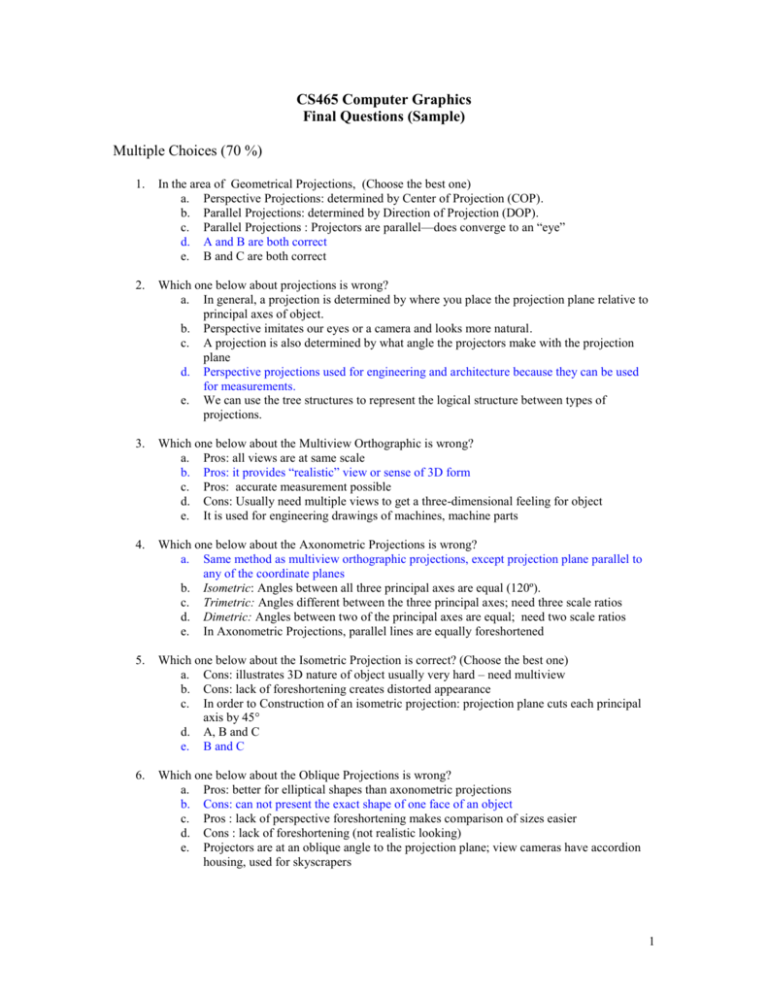
CS465 Computer Graphics Final Questions (Sample) Multiple Choices (70 %) 1. In the area of Geometrical Projections, (Choose the best one) a. Perspective Projections: determined by Center of Projection (COP). b. Parallel Projections: determined by Direction of Projection (DOP). c. Parallel Projections : Projectors are parallel—does converge to an “eye” d. A and B are both correct e. B and C are both correct 2. Which one below about projections is wrong? a. In general, a projection is determined by where you place the projection plane relative to principal axes of object. b. Perspective imitates our eyes or a camera and looks more natural. c. A projection is also determined by what angle the projectors make with the projection plane d. Perspective projections used for engineering and architecture because they can be used for measurements. e. We can use the tree structures to represent the logical structure between types of projections. 3. Which one below about the Multiview Orthographic is wrong? a. Pros: all views are at same scale b. Pros: it provides “realistic” view or sense of 3D form c. Pros: accurate measurement possible d. Cons: Usually need multiple views to get a three-dimensional feeling for object e. It is used for engineering drawings of machines, machine parts 4. Which one below about the Axonometric Projections is wrong? a. Same method as multiview orthographic projections, except projection plane parallel to any of the coordinate planes b. Isometric: Angles between all three principal axes are equal (120º). c. Trimetric: Angles different between the three principal axes; need three scale ratios d. Dimetric: Angles between two of the principal axes are equal; need two scale ratios e. In Axonometric Projections, parallel lines are equally foreshortened 5. Which one below about the Isometric Projection is correct? (Choose the best one) a. Cons: illustrates 3D nature of object usually very hard – need multiview b. Cons: lack of foreshortening creates distorted appearance c. In order to Construction of an isometric projection: projection plane cuts each principal axis by 45° d. A, B and C e. B and C 6. Which one below about the Oblique Projections is wrong? a. Pros: better for elliptical shapes than axonometric projections b. Cons: can not present the exact shape of one face of an object c. Pros : lack of perspective foreshortening makes comparison of sizes easier d. Cons : lack of foreshortening (not realistic looking) e. Projectors are at an oblique angle to the projection plane; view cameras have accordion housing, used for skyscrapers 1 7. How to represent point in a 2D or 3D homogeneous coordinate system? a. (x, y) => (xz, yz, z) = (x, y, 1) b. (x, y, z) => (xw, yw, zw, w) = (x, y, z, 0) c. (x, y) => (xz, yz, 0) = (x, y, 0) d. (x, y, z) => (xw, yw, zw, w) = (x, y, z, -1) e. None of above are correct 8. A Conical view volumes (Choose which one is wrong) a. Approximates what eye sees b. Can approximate with rectangular cone instead (called a frustum) c. Cons : frustum is not working well with a rectangular viewing window d. frustum simultaneous linear equations for easy clipping of objects against sides e. Cons : expensive math (simultaneous quadratics) when clipping objects against cone’s surface 9. Perspective Projection is different from a parallel projection because a. parallel lines not parallel to the projection plane converge b. size of object is diminished with distance c. foreshortening is not uniform d. A and B and C e. A, B 10. What is (are) High Level goals of UI? a. Optimize human factors and ergonomics b. Minimize error rate c. Make easy things easy; make hard things possible d. Consistency with user’s expectation e. All of the above 11. What is correct in the following viewport transformation, (pick the best answer) a. It could involves the product of an arbitrary sequence of rotation, translation, and scale matrixes b. Translation: preserve angles and length c. Rotation: preserve angles and length d. Scaling: preserve parallelism, but not preserve angles and length e. All of the above are correct 12. What is Rules for placing projection plane for oblique views? a. it is parallel to the most irregular of the principal faces b. or to the one which contains circular or curved surfaces c. it is parallel to the longest principal face of the object d. it is parallel to the face of interest e. All of the above 13. What is the difference or common places between Cavalier and Cabinet Projection? (Choose the WRONG one) a. Cavalier: Angle between projectors and projection plane is 45º. b. Cabinet: Angle between projectors and projection plane is arctan(2) = 63.4º. c. Cavalier: Perpendicular faces are projected at 50% scale d. Cavalier: Perpendicular faces are projected at full scale e. Cabine and Cabinet are main Types of Oblique Projections. 14. How to rotate or scale about a non-origin point? a. First rotate this point b. First scale this point 2 c. d. e. First translate this point to any destination First translate this point to the origin None of above is correct Q & A (Please answer each question brief.) (30%) 1. What are six things about our synthetic camera model in order to take a computer picture? (6%) Position, Look vector, Orientation, Aspect ratio, Height angle, Front and back clipping planes 2. Can you draw a simple picture to represent the six things? (8%) Up vector Width angle Look vector Position 3. Height angle Front clipping plane Back clipping plane Please draw a picture to represent Orthographic and Oblique Projections? (6%) 3 4. What is the “Conceptual Model of 3D Viewing Process”? (Please draw a diagram and explain it.) (10%) 4

